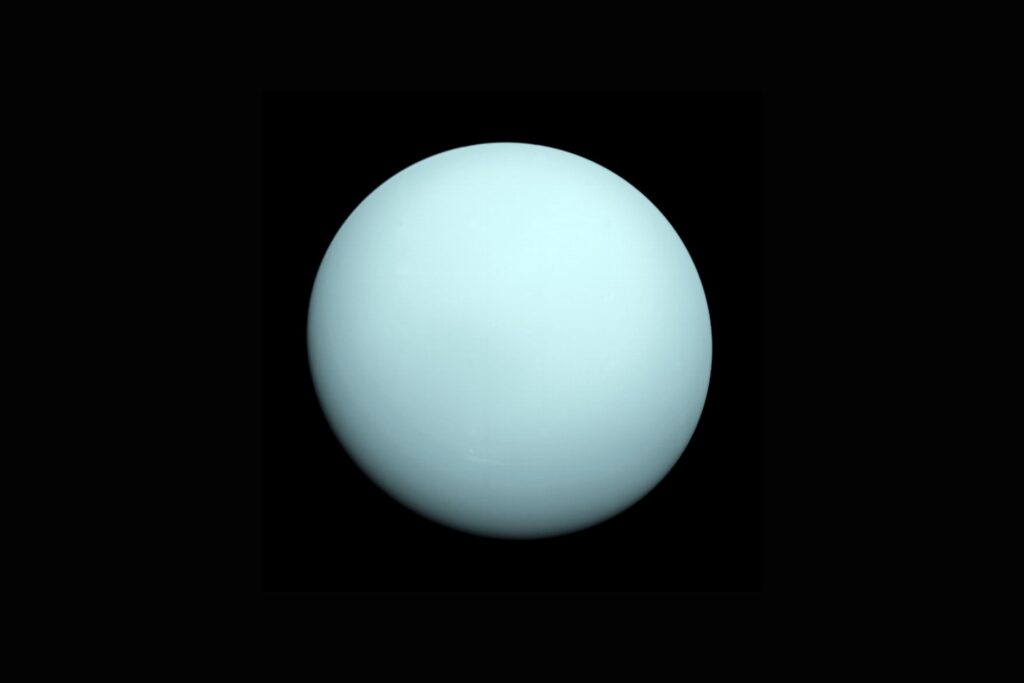Uranus is the seventh planet from the Sun. It is the planet with the third largest diameter, but it is the fourth heaviest after Jupiter, Saturn, and Neptune. The following are some interesting facts about Uranus. Let’s read.
Facts about Uranus (everything you need to know)
Orbit of Uranus
- Uranus orbits at a distance of 1.8 billion miles (average) from the Sun. 1.8 billion miles is approximately equal to 19.8 Astronomical Units (AU). 1 Astronomical Unit is the average distance of Earth from the Sun. In other words, the distance of Uranus from the Sun is 19.8 times the distance of the earth from the Sun.
1.8 billion miles = 2.9 billion km
ADVERTISEMENT
- Uranus takes 30,687 Earth days to complete one revolution around the Sun.
1 Uranus year = 84 Earth years
- Uranus takes only 17 hours and 14 minutes to complete one rotation around its axis.
1 Uranus day = 0.72 Earth day

Physical Overview of Uranus
- Water, methane, and ammonia make up more than 80% of the planet’s mass. These compounds are present in a hot, dense fluid state.
- In planetary science compounds with a melting point above 100 kelvin are known as “ices”. Since water, methane, and ammonia have melting points above 100 kelvin, Uranus is known as an “ice giant“.
- Uranus’s upper atmosphere is mostly made up of hydrogen, helium, and a small amount of methane. The planet gets its blue-green color because of methane as it absorbs most of the red light from the Sun.
- Uranus does not have a true surface. It has a small rocky core. The temperatures near the core are as high as 4,982 degrees Celsius (9,000 degrees Fahrenheit).
- The outermost parts of the planet have very low temperatures, as low as -224 degrees Celsius (-371 degrees Fahrenheit). Uranus is the planet with the coldest recorded temperature.
- Uranus’s average density is one-fourth that of Earth’s. In fact, it is the second least dense planet in our solar system after Saturn.
Earth’s average density = 5,514 kg/m3
Uranus’s average density = 1,271 kg/m3
ADVERTISEMENT
- Uranus is four times wider than Earth.
Mean radius of Uranus = 25,362 km
Mean radius of Earth = 6,371 km
- Uranus is 14.5 times heavier than Earth.
Mass of Uranus = 86.813 * 10^24 kg
Mass of Earth = 5.9724 * 10^24 kg
- Uranus’s rotational axis is tilted at an angle of 97.77 degrees with respect to its orbital axis. You can imagine Uranus as the planet that is rolling around the Sun.

Rings of Uranus
All four giant planets have rings around them. Uranus has 13 rings. These rings are named as Zeta, 6, 5, 4, Alpha, Beta, Eta, Gamma, Delta, Lambda, Epsilon, Nu and Mu (ζ, 6, 5, 4, α, β, η, γ, δ, λ, ε, ν and μ) in the increasing order of their distance from Uranus.
The rings differ in composition from each other but in general, they are made up of large, dark bodies ranging in size from 0.2-20 m with very little dust.
Natural satellites of Uranus
- There are 28 known moons of Uranus. The three largest ones are Titania, Oberon,
and Umbriel. - Titania is the largest moon of Uranus. It is also the eighth-largest moon in our solar system.
- Interestingly, most moons of Uranus are named after the characters from the works of William Shakespeare and Alexander Pope.
Uranus vs Earth comparison
| Uranus | Earth | |
|---|---|---|
| Radius | 25,362 km (15,759.2 miles) | 6,371 km (3,959 miles) |
| Mass | 86.813 * 10^24 kg | 5.9724 * 10^24 kg |
| Planet type | Gas/Ice giant | Terrestrial |
| Position from the Sun | 7th | 3rd |
| Day length | around 17 hours 14 minutes | around 23.9 hours |
| Year length | 84 Earth years | 365.25 days |
| Time taken by sunlight to reach | around 2 hours 40 minutes | 8 minutes 20 seconds |
| Average distance from the Sun | 2.9 billion km (1.8 billion miles) | 150 million km (93 million miles) |
| Ring System | Yes | No |
ADVERTISEMENT
Additional facts about Uranus
- Uranus was discovered by William Herschel on 13 March 1781.
- Uranus was the first planet to be discovered with the help of a telescope.
- Sunlight takes about 2 hours and 40 minutes to reach Uranus.
- So far only the Voyager-2 spacecraft
has visited Uranus. - Uranus was named after the Greek primordial god of the sky.
- The winds on Uranus can reach a speed of 560 miles/hr (901 km/hr). Near the equator, the wind direction is opposite to the direction of rotation. Near the poles, the wind direction is the same as the direction of rotation.
- Uranus and Venus are the two planets that rotate from east to west.
Quick question
Which is the largest dwarf planet?
Read more
Answer to quick question
Pluto is the largest dwarf planet. Eris is the second largest.